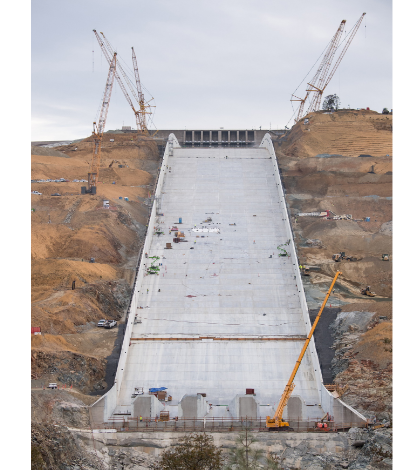DWR Meets the Nov. 1 Public Safety Milestone
After a year-and-a-half of tireless construction, often with crews working throughout the night, the Department of Water Resources (DWR) has successfully met the Nov. 1 Public Safety Milestone in repairing the heavily damaged Oroville Dam main spillway. The dam’s main spillway and the adjacent emergency spillway were ravaged in early Feb. 2017 as northern California experienced unprecedented atmospheric rivers and sustained storms. During two separate flow tests down the main spillway on February 8–9, a crater initially measuring 250 ft (76 m) was identified — and it continued to grow.
Meanwhile, on February 11, the Oroville Lake level topped 901 ft (275 m) above sea level and water began flowing over the concrete weir along the top of the emergency spillway, cascading onto the emergency spillway for the first time in the dam’s history. The erosion at the base of the weir progressed much faster than anticipated and the erosion of the emergency spillway threatened to undermine and collapse the concrete weir. On Feb. 12, an emergency evacuation order for the downstream Oroville area — in Butte, Yuba and Sutter counties – was called because of the potential failure of the emergency spillway. Fortunately, the rain ceased and the danger of the dam’s collapse was averted.
Although many opinions have been offered in accounting for the Oroville Dam spillways disaster the Jan. 5, 2018 Independent Forensic Team Report on the Oroville Dam Spillway Incident stated that: “There was no single root cause of the Oroville Dam spillway incident, nor was there a simple chain of events that led to the failure of the service spillway chute slab, the subsequent overtopping of the emergency spillway crest structure, and the necessity of the evacuation order. Rather, the incident was caused by a complex interaction of relatively common physical, human, organizational, and industry factors, starting with the design of the project and continuing until the incident.”
In wrapping up the reconstruction of the main Oroville Dam spillway and successfully meeting the Nov. 1 Public Safety Milestone, Tony Meyers, DWR Project Manager for the Oroville Spillways Emergency Recovery Project said, “More than 700 construction workers, many of them from Butte County and other parts of Northern California, literally worked day and night to make incredible progress during the 2018 construction season. Staff from nearly every corner of DWR worked on the project in some capacity over the past year and a half and their planning, execution and hard work contributed to meeting this November 1 milestone.”
Dry finishing, joint sealing, completing sidewall backfill and site clean-up on the main spillway will also continue after November 1. The new concrete on the main spillway will have cured by December 1, in time for the rainy season and use of the main spillway if necessary.
The work in the last month on both the main spillway and the emergency spillway have included:
Main Spillway
- The main spillway has now been reconstructed to its original design capacity of 270,000 cubic feet of water per second.
- The final erosion-resistant concrete (ERC) slab was placed on Thursday, Oct. 11. Combined with work in 2017, a total of 612 new ERC concrete slabs have been installed (378 in 2018).
- Crews placed the final ERC wall on Thursday, Oct. 18. A total of 204 new ERC concrete walls have been installed of which 126 were completed in 2018.
- Final concrete placements on the energy dissipaters, or dentates, at the base of the main spillway were completed on Saturday, Oct. 20.
Emergency Spillway
- The roller-compacted concrete (RCC) splashpad was completed on Friday, Oct. 26. Crews placed approximately 700,000 cubic yards of roller-compacted concrete on the splashpad.
- The RCC buttress at the base of the emergency spillway was also completed earlier this month.
- Placement of a structural concrete cap connecting the RCC buttress to the emergency spillway structure will be complete in early 2019.
In announcing the completion of the Public Safety Milestone, the DWR also announced it has completed an operations plan for the 2018-19 flood season that will guide reservoir operations from November 2018 through April 2019. The plan calls for DWR to maintain lower-than-average lake levels during the winter months to provide operational flexibility to ensure flood protection, meet water deliveries, meet environmental requirements, and prevent use of the emergency spillway this winter. Construction is slated to continue on the emergency spillway into early 2019. The updated plan was completed with recommendations from the U.S. Army Corps of Engineers, the Federal Energy Regulatory Commission and the Division of Safety of Dams.
 California Water News Daily Your Source For Water News in California
California Water News Daily Your Source For Water News in California


